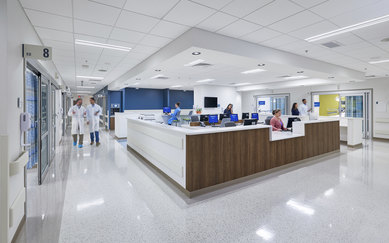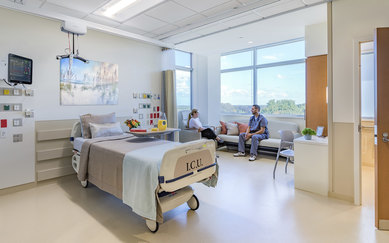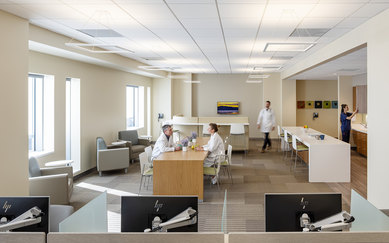Did Architects Ruin Healthcare? The Case for Patient-Centered Design
Everyone is familiar with clickbait: internet headlines or images specifically designed to entice you into time-wasting rabbit holes. Whenever I’m online, I try to avoid it; however, it was impossible to ignore the recent headline of a short op-ed, "How Architects Ruined Healthcare." As a healthcare architect, this was clickbait that I couldn’t resist.

The commentary was written by Joshua Landy, a critical care physician, in the Canadian-based newspaper, The Globe and Mail. Dr. Landy’s central thesis is that the recent design "obsession" of healthcare architects over patient-centered care has served to ignore the physician and hospital staff. He goes on to suggest the current crisis of physician burnout is linked to this shift in design emphasis. I was surprised by this suggestion as my understanding is that physician burnout is rooted in the changing economic and bureaucratic challenges of the medical profession. My own primary care physician recently retired from the medical profession at age 54 and moved to Costa Rica. He often expressed to me his frustration with the administrative burdens of his practice and the limited time he had available to spend with patients.
Dr. Landy traces the roots of this shift to a more patient-centered design approach to a 2012 paper by Dr. Elizabeth Bromley, a medical anthropologist and psychiatrist at the University of California. He believes that these patient-centered design principles serve to "conceal from the visiting public the techniques that constitute the work that produces or defines the setting." However, it’s not clear if what Dr. Landy is advocating is that we should design hospitals to make the movement of staff, supplies, and equipment (and perhaps trash?) more apparent to the visiting public, nor does he identify how this change would improve healthcare delivery and patient outcomes.
This view also runs counter to current practice. Today, we design healthcare environments to intentionally showcase advanced medical technologies rather than treating them as scary machines to be hidden away—the "techniques that constitute the work." Even the definition of patient-centered care has evolved since Dr. Bromley's paper was published. What used to mean bringing services to the patient's bedside has grown to encompass a larger sphere of consumer-driven healthcare and a fuller engagement between patients, family, staff, and the community.
Dr. Landy may be on firmer ground when he talks about the lack of staff meeting space in new hospitals. While it may be true that physician lounges and dedicated physician dining spaces are not prioritized as they once were, they are not "a thing of the past." Perhaps his issue is with the shift from the primacy of the physician to a model of care that promotes interprofessional care teams. We are designing more spaces that support and encourage that team-based collaboration: larger nurse (team) stations, distributed stations and touch down spaces, and a variety of other work spaces (heads down, conference/consult, rounding)—and staff lounges that are multi-functional as well as have more amenities. SmithGroup’s workplace research shows that staff productivity and well-being is enhanced by having a choice of both collaborative and focused workspaces.

Dr. Landry specifically faults administrators and designers who have adopted Disney's design principles—particularly the design philosophy that hides the technical and "messy" aspects of its theme parks, such as a pneumatic tube system for waste disposal. He asserts that, in applying Disney design principles to healthcare, physicians are now a component of that messy part that needs to be hidden and de-emphasized. He does not acknowledge the larger on-stage/off-stage philosophy of design—whether in a theme park, school or hospital—which is intended to promote staff well-being by giving them time to be off-stage for part of their workday. Off-stage work areas can also reduce noise and clutter in patient areas and corridors, increase staff communication, and improve workflow and efficiency.
Dr. Landy also takes issue with healthcare designers’ efforts to provide positive distractions in the built environment, saying, "Healthcare that doesn’t look like healthcare is not healthcare. It is a sort of theater created to distract an audience of anxious patients. It doesn’t serve their interests. It’s a funhouse mirror vision of patient-centered care, where it’s more important to pretend you’re not sick than to be properly treated."
It’s not clear from the article what he believes healthcare should look like: is there a design approach or aesthetic from the past that he wants us to return to? Evidence-based design studies have shown that access to natural light, nature, and positive distractions can speed recovery and lower the length of stay, reduce the need for pain meds, and improve overall patient well-being. We also know that access to natural light and nature can improve the staff's satisfaction, cognition, and performance—which has the added benefit of reducing errors and hospital-acquired infections.
While there is no doubt that the issues in our healthcare system are messy and complex, how healthcare is delivered—and in what setting—is being reinvented every day, and generally for the better. Healthcare designers and our clients are absolutely committed to the "for the better" part, carefully balancing the family- and patient-centered experience with a staff-centric, team-based approach to support a shared goal: the health and well-being of the patient. In the process, we are borrowing from retail, hospitality, and workplace environments, and yes, even Disney. As a healthcare architect, I'm on board with that.
Bromley, E., 2012. Building patient-centeredness: hospital design as an interpretive act. Social Science & Medicine, 75, 6, 1057–66.
This post originally stated that the use of on-stage/off-stage work areas had been proven to improve efficiency and staff communication and reduce corridor clutter and noise. A reader pointed out that the use of the word "proven" was misleading, as there are no evidence-based studies as yet on the efficacy of this concept in inpatient design. The post has been updated.
